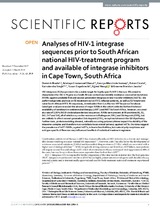| dc.contributor.author | Brado, Dominik | |
| dc.contributor.author | Obasa, Adetayo Emmanuel | |
| dc.contributor.author | Ikomey, George Mondinde | |
| dc.contributor.author | Cloete, Ruben | |
| dc.contributor.author | Singh, Kamalendra | |
| dc.contributor.author | Engelbrecht, Susan | |
| dc.contributor.author | Neogi, Ujjwal | |
| dc.contributor.author | Jacobs, Graeme Brendon | |
| dc.date.accessioned | 2018-03-27T09:51:28Z | |
| dc.date.available | 2018-03-27T09:51:28Z | |
| dc.date.issued | 2018 | |
| dc.identifier.citation | Brado, D. et al. (2018). Analyses of HIV-1 integrase sequences prior to South African national HIV-treatment program and available of integrase inhibitors in Cape Town, South Africa. Scientific Reports, 8: 4709 | en_US |
| dc.identifier.issn | 2045-2322 | |
| dc.identifier.uri | http://dx.doi.org/10.1038/s41598-018-22914-5 | |
| dc.identifier.uri | http://hdl.handle.net/10566/3583 | |
| dc.description.abstract | HIV-Integrase (IN) has proven to be a viable target for highly specific HIV-1 therapy. We aimed to
characterize the HIV-1 IN gene in a South African context and identify resistance-associated mutations
(RAMs) against available first and second generation Integrase strand-transfer inhibitors (InSTIs). We
performed genetic analyses on 91 treatment-naïve HIV-1 infected patients, as well as 314 treatmentnaive
South African HIV-1 IN-sequences, downloaded from Los Alamos HIV Sequence Database.
Genotypic analyses revealed the absence of major RAMs in the cohort collected before the broad
availability of combination antiretroviral therapy (cART) and INSTI in South Africa, however, occurred
at a rate of 2.85% (9/314) in database derived sequences. RAMs were present at IN-positions 66, 92,
143, 147 and 148, all of which may confer resistance to Raltegravir (RAL) and Elvitegravir (EVG), but
are unlikely to affect second-generation Dolutegravir (DTG), except mutations in the Q148 pathway.
Furthermore, protein modeling showed, naturally occurring polymorphisms impact the stability of the
intasome-complex and therefore may contribute to an overall potency against InSTIs. Our data suggest
the prevalence of InSTI RAMs, against InSTIs, is low in South Africa, but natural polymorphisms and
subtype-specific differences may influence the effect of individual treatment regimens. | en_US |
| dc.language.iso | en | en_US |
| dc.publisher | Nature Publishing Group | en_US |
| dc.rights | Open Access This article is licensed under a Creative Commons Attribution 4.0 International
License, which permits use, sharing, adaptation, distribution and reproduction in any medium or
format, as long as you give appropriate credit to the original author(s) and the source, provide a link to the Creative
Commons license, and indicate if changes were made. The images or other third party material in this
article are included in the article’s Creative Commons license, unless indicated otherwise in a credit line to the
material. If material is not included in the article’s Creative Commons license and your intended use is not permitted
by statutory regulation or exceeds the permitted use, you will need to obtain permission directly from the
copyright holder. To view a copy of this license, visit http://creativecommons.org/licenses/by/4.0/. | |
| dc.subject | Combination antiretroviral therapy (cART) | en_US |
| dc.subject | HIV infection | en_US |
| dc.subject | HIV-Integrase (IN) | en_US |
| dc.subject | HIV-1 therapy | en_US |
| dc.subject | Dolutegravir (DTG) | en_US |
| dc.title | Analyses of HIV-1 integrase sequences prior to South African national HIV-treatment program and available of integrase inhibitors in Cape Town, South Africa | en_US |
| dc.type | Article | en_US |
| dc.privacy.showsubmitter | FALSE | |
| dc.status.ispeerreviewed | TRUE | |

